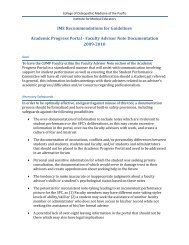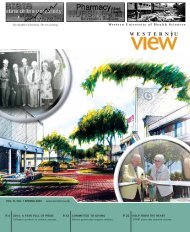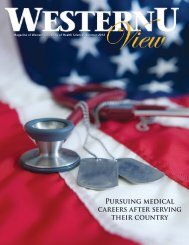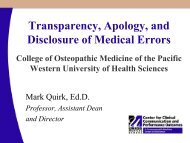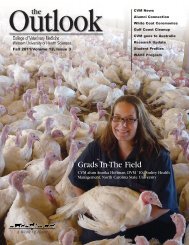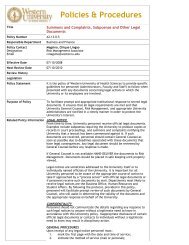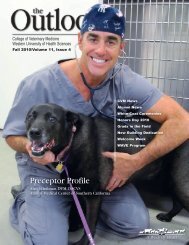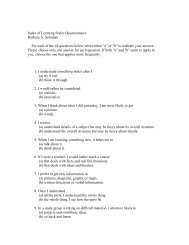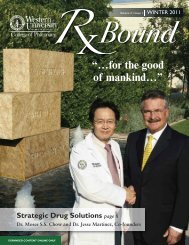Research - Western University of Health Sciences
Research - Western University of Health Sciences
Research - Western University of Health Sciences
You also want an ePaper? Increase the reach of your titles
YUMPU automatically turns print PDFs into web optimized ePapers that Google loves.
PROFILELife as an ArmyDoc in IraqBy Maj. Alea Morningstar, DO, ’96OOn Sept. 11, 2001, I was on a flight landingimmediately in Phoenix. Numbed, mutedconversations with a group <strong>of</strong> Army doctorsslowly turned to overseas experiences. Theirpassion fired me tosign up.After two years inIraq - in Baghdad,Abu Ghraib prisonand five diverseArmy Units - Ishare mine.Iraq is sandstormsand 120-plusdegreedays orrainy, cold mud inthe winter.I have held dying soldiers and Marines.Returned hostile fire. Treated andArmy Maj. Alea Morningstar (right) with colleagues atAl-Asad Airfield west <strong>of</strong> Baghdad, Iraq.medevacked (medical evacuation byhelicopter) the wounded and <strong>of</strong>fered ashoulder to cry on.Being “outside the wire” (outside securedareas) is hell. We carry50 pounds <strong>of</strong> individualbody armor,a Kevlar helmet andweapons, plus packsand ammo.No showers, no sleep.MREs (meals ready toeat) in crampedHumvee convoys.An IED (improvisedexplosive device)booms. Ears ring, and the pungent syrupysmell <strong>of</strong> burning flesh and grimy smokechoke and blind you. Medics move out4 <strong>Western</strong> <strong>University</strong> <strong>of</strong> <strong>Health</strong> <strong>Sciences</strong>
toward the screams.Small arms fire staccatosand blood casts ametallic tang in yourmouth. You are inagonizingly intensesurvival mode,rendering care whiletrying to stay alive.We pick up body partsA tank battle takes place in the streets <strong>of</strong> Al Mumidiyah, Iraq.<strong>of</strong> friends. Well over 90percent we medevac will make it.Once inside the wire we shower, wolf hot chow andsleep. Many soldiers, Marines and medics repeatthis exhausting and dangerous cycle <strong>of</strong> patrols andmissions. No one complains.As Battalion Surgeon with the 391st MPs at AbuGhraib Prison, my section housed over 2,000detainees. With one PA and 26 medics, we ran anaid station for troops, and 24/7 care for detainees.(Inpatients stayed at the 115th Field Hospital.)With nonstop mortar attacks, small-arms fights andcasualties—the eyes <strong>of</strong> the world watched us“Restore America’s Honor.”One 1-153 Infantry medic had four purple hearts.They managed car bombs and IEDs where bodiesburned beyond recognition or draped the scenelike icicles.Al-Asad was howling 140-degree sandstorms, over2,000 soldiers, two medics and 24/7 days.Transportation Companies and Marines took heavylosses—we did our best.This tour I am an ER physician. With the 21st CSH,we cared for more than 18,000 detainees!I recuperate at WalterReed Medical Centerfrom shrapnelwounds, adrift in asea <strong>of</strong> high techprosthetics and troopswhose courageastounds me. Most <strong>of</strong>us suffer variousstages <strong>of</strong> TBI(traumatic braininjury) with shorttermmemory loss, headaches and dizziness.A spot in the right frontal lobe on my MRI mayend my career.I hope I am OK.With combat experience and medals I am now aveteran--a “Wounded Warrior.” We feel “awakeamong the sleeping”—as everyone’s lives have goneon unchanged while our eyes are OPEN to what wehave in America. There are NO WORDS—or regrets.The 399th CSH in Tikrit—Saddam’s hometown—sees massive trauma, mangled limbs, and GSWs.Whole blood and Factor 7 transfusions save manylives. It is hard, bloody work. Like an episode <strong>of</strong>M.A.S.H., this highly trained group <strong>of</strong> nurses,physicians and surgeon’s camaraderie is infectious.Army Maj. Alea Morningstar, DO ’96, has served three tours in Iraq,totaling more than two years. She graduated in 1996 from theCollege <strong>of</strong> Osteopathic Medicine <strong>of</strong> the Pacific at <strong>Western</strong> <strong>University</strong><strong>of</strong> <strong>Health</strong> <strong>Sciences</strong>. She wrote this story exclusively for <strong>Western</strong>UView magazine about her wartime experiences while recoveringfrom an injury suffered in Baghdad. Her e-mail address isalea.morningstar@us.army.mil.<strong>Western</strong>U View Spring 2008 5
30 Years <strong>of</strong> MemoriesBy Rodney TanakaSenior Communications WriterTThirty years ago, the College <strong>of</strong> Osteopathicbe able to pull this <strong>of</strong>f,’ ” he said.Medicine <strong>of</strong> the Pacific brought togetherBut he liked what President Philip Pumerantzpioneering administrators, faculty andand the other founders were trying to do,students who were willing to take chances.said Ross, an emergencyWhat formed was a bondphysician at Penrose Hospitalthat continues to this day.in Colorado Springs, Colo.The college, now part <strong>of</strong>“I like being different and a<strong>Western</strong> <strong>University</strong> <strong>of</strong>little unique,” he said. “I<strong>Health</strong> <strong>Sciences</strong>, startedthought this is the type <strong>of</strong>out in a renovatedenvironment that will allowshopping center. Thereme to be that way.”weren’t really any facilitiesThe campus was small andto look at whenhad a real familyinterviewing forDavid Ross, DO ’82 during COMP’s environment in those earlyadmission, said Davidcharter class commencementyears, said Dr. Rafi Younoszai,Ross, DO ’82, who was inCOMP Pr<strong>of</strong>essor <strong>of</strong> Anatomy/Director <strong>of</strong>the first graduating class <strong>of</strong> COMP.International Cross-cultural Programs, who“I thought, ‘I don’t know if they’re going to joined the faculty in 1979.6 <strong>Western</strong> <strong>University</strong> <strong>of</strong> <strong>Health</strong> <strong>Sciences</strong>
FEATUREGrowth at the college provided“I think some <strong>of</strong> that samea lot <strong>of</strong> opportunities. Hemotivation and drive is still there,developed the first COMPit’s just on a much bigger scalefaculty and student talent show,than it was back then.”a wellness club and wellnessCOMP gave an opportunity tosymposiums, as well as otherpeople who might not haveJosef Strazynski, DO ’82clubs that sent students toreceived one in other settings, saidoverseas exchange programsLinda Crawford, DO ’83, a full-time familyand to community service projects.practitioner in Sierra Madre, Calif.“These experiences to me were very rewarding,”COMP was an inclusive university that was willingYounoszai said. “I’m glad we started these programsto take a chance on intelligent people, saidearly. Now it’s paying <strong>of</strong>f.”Crawford, who had a bachelor’s in nursing whenStudents came in with varied life experiences and she applied to COMP.quickly formed a very solid, united group, said Josef“Administration tried to make it possible for peopleStrazynski, DO ’82, who runs a private clinicwho had a burning desire to further their career inspecializing in treatment <strong>of</strong> vascular complicationsmedicine,” she said.“<strong>of</strong> diabetes mellitus in Israel.Students were willing toHe fondly remembers private chats with the faculty help each other, formingThe faculty was notand fun gatherings with Harriet and Philipa cohesive group thatjust our teachers, theyPumerantz.helped each other andbecame our friends“The faculty was not just our teachers, they became shared in each other’sand mentors.our friends and mentors,” Strazynski said.triumphs.Students got creative in developing places to study “We worked collectively -- Josef Strazynski,and relax, said Thom Horowitz, DO ’82, who has a to learn things,DO ’82private practice in downtown Los Angeles. One something that I think isclassmate convinced the owner <strong>of</strong> a sandwich shop wonderful,” Crawford said. “I carried that throughacross the street to give him the keys so students to my pr<strong>of</strong>essional life. We will do everything wecould go there at night to study, he said. They can to help everyone do the best they can.”would make their own sandwiches and put money She is proud <strong>of</strong> the growth at <strong>Western</strong>U.in the till. That same resourcefulness was also“We went from being a very little school strugglingreflected in their medical training.to make a reputation to being a thriving mega“You had to be self motivating and studyuniversity that puts out quality physicians andindependently,” Horowitz said.nurses, pharmacists and physical therapists,”Going to COMP reinforced the idea <strong>of</strong> beingCrawford said. “It’s wonderful to be a part <strong>of</strong> that.persistent in achieving your goals, Ross said. He sees People now know <strong>Western</strong>U. It’s a neat thing,a similar spirit still alive today at <strong>Western</strong>U.because we were there when nobody knew who“<strong>Western</strong>U really impresses me today,” Ross said. we were.”“<strong>Western</strong>U View Spring 2008 7
<strong>University</strong> Turns 30 With aGrowth Spurt AheadBy Will BighamInland Valley Daily BulletinAAs <strong>Western</strong> <strong>University</strong> <strong>of</strong> <strong>Health</strong> <strong>Sciences</strong>celebrates its 30th anniversary, thedowntown medical school is moving forwardwith ambitious expansion plans that willmore than double its enrollment.In 1977, the university was a one-roomoperation with 36 students. Now, situated ona sprawling 22-acre campus, the universityboasts five separate schools and more than2,000 students. In 2009, the university willopen three new schools, and in 2010 willbegin planning for two more. By the time theexpansion concludes, <strong>of</strong>ficials expectNow: <strong>Western</strong>U students make their way to classes.enrollment to exceed 5,000. When PhilipPumerantz, the school’s founding president,arrived in Pomona with the mission to set upthe university, he was working with“borrowed furniture and a broken phone,” ashe characterizes those early days. Theuniversity began with one school - theCollege <strong>of</strong> Osteopathic Medicine - whichteaches a medical discipline that emphasizesthe complete treatment <strong>of</strong> a patient ratherthan focusing on a specific ailment.<strong>Western</strong>U, one <strong>of</strong> 22 osteopathic medicalschools in the country, produces graduates8 <strong>Western</strong> <strong>University</strong> <strong>of</strong> <strong>Health</strong> <strong>Sciences</strong>
FEATUREwho first are medically competent, but “they’re alsocaring and compassionate,” said Pumerantz, 74.Since its founding, <strong>Western</strong>U has added colleges <strong>of</strong>veterinary medicine, pharmacy, nursing and alliedhealth pr<strong>of</strong>essions. With multiple schools oncampus, students are exposed to a variety <strong>of</strong>training methodsthat makes themwell-roundeddoctors, Pumerantzsaid. The set up“breaks down thesilos” betweenmedicaldisciplines, he said.As it has grown,<strong>Western</strong>U hasadded specializedprograms such asthe Center for Disability Issues and the <strong>Health</strong>Pr<strong>of</strong>ession, which aides disabled students whoattend the university. “Over 90 percent havegraduated, and a number <strong>of</strong> them have graduated atthe top <strong>of</strong> their classes,” said Brenda Premo, thecenter’s founding director. Premo said <strong>Western</strong>U’sstudent body consists <strong>of</strong> “grass-roots people” whohave concern for individual patients. “They don’ttalk about the kidney in room 3, they talk aboutMs. Jones,” she said. “Students who come here, theytend to reflect the communities they come from,and they tend to go back to the communities theycome from.”New Colleges PlannedSchools <strong>of</strong> dentistry, optometry, and podiatry willopen in 2009. As part <strong>of</strong> the expansion, more than200,000 square feet <strong>of</strong> new building space is beingconstructed at a cost <strong>of</strong> $120 million, Pumerantzsaid. Planning will begin in 2010 for a School <strong>of</strong>Then: Original site was a retail shopping mall.Public <strong>Health</strong> and a School <strong>of</strong> Biomedical <strong>Sciences</strong>,Pumerantz said. After the expansion is completed,opening additional campuses in the western UnitedStates willlikely be“considered,<strong>Western</strong>U preparedPumerantzme better than yoursaid.typical medicalArmy Maj. Aleaschool.Morningstar,-- Army Maj. AleaDO, ’96, aMorningstar, DO, ’96militaryphysician whohas served a total <strong>of</strong> two years in Iraq, graduatedfrom <strong>Western</strong>U in 1996. While serving in Baghdadin July 2004, Morningstar was hit in both legs byshrapnel from a roadside bomb. The injuries werenot life-threatening, and soon after she returned tomedical work. Morningstar said her training as anosteopathic physician has been especially helpful inher treatment <strong>of</strong> soldiers, whose injuries are <strong>of</strong>tenmultiple and complex. “(<strong>Western</strong>U) prepared mebetter than your typical medical school,”Morningstar said. “I’ve learned to talk to people andlisten to people much better from being at a schoolthat emphasized that part <strong>of</strong> being a doctor.”Reprinted by permission from the Inland Valley Daily Bulletin.“<strong>Western</strong>U View Spring 2008 9
Building on SuccessBy Rodney TanakaSenior Communications Writer<strong>Western</strong> <strong>University</strong> <strong>of</strong> <strong>Health</strong> <strong>Sciences</strong> istraveling down a bold new path, one builtfrom scratch.The university is building new facilities fromthe ground up for the first time in itshistory. <strong>Western</strong>U had previously renovatedstructures to suitits educationaland institutionalneeds.Phillip Nelson, DVM,Dean <strong>of</strong> the College <strong>of</strong> Veterinary Medicine“We get to buildthe newbuilding to suitthe program asopposed totrying to alteran existing retailbuilding into aschool building,which istougher to do ina renovation,”said Todd Clark,<strong>Western</strong>Ufacilities andphysical plantdirector.Construction on the veterinary medicalbuilding began in August and is expected tobe completed in early 2008. Three additionalbuildings are planned: the VeterinaryInstructional Pathology Center, the <strong>Health</strong>Education Center and the Patient CareCenter.“This is an exciting time <strong>of</strong> growth for theuniversity, both <strong>of</strong> programs and physicalfacilities,” said Shirley Johnston, DVM, PhD,vice president <strong>of</strong> <strong>University</strong> Advancement.“We have completed the transformation <strong>of</strong>all existing buildings on our campus, andnow have the opportunity to construct newones to serve our vision <strong>of</strong> the future.”The new veterinary medical building willallow the College <strong>of</strong> Veterinary Medicine tohouse its entire faculty in one building andwill double the teaching space, said PhillipNelson, DVM, PhD, dean <strong>of</strong> the College <strong>of</strong>Veterinary Medicine. Watching the buildinggo up is extremely exciting and fulfilling, hesaid.“At the same time, it reminds me <strong>of</strong> thework that was done before me andstimulates me to make sure we continue togrow,” Nelson said. “I’m appreciative to thepeople that funded this project for us. At thesame time I’m committed and challenged tomake sure we put this building to good use.”The <strong>Health</strong> Education Center will be thenew home <strong>of</strong> the College <strong>of</strong> OsteopathicMedicine <strong>of</strong> the Pacific and the three newcolleges opening in 2009 – the College <strong>of</strong>Dental Medicine, the College <strong>of</strong> Optometry10 <strong>Western</strong> <strong>University</strong> <strong>of</strong> <strong>Health</strong> <strong>Sciences</strong>
and the College <strong>of</strong> Podiatric Medicine.The first floor will have four auditoriums and faculty<strong>of</strong>fices. The second and third floors will have largeauditoriums with 350 seats each. The College <strong>of</strong>Optometry and COMP will be on the first and secondfloors. The College <strong>of</strong> Podiatric Medicine and the College<strong>of</strong> Dentistry will be on the third floor and research labswill be on the fourth floor.The construction will allow the university to design afacility that will support an innovative curriculum, saidJames Koelbl, DDS, MS, MJ, founding dean <strong>of</strong> the College<strong>of</strong> Dental Medicine.“When you inherit an existing building, sometimes youhave to work around limitations the physical plantprovides,” he said. “We have the opportunity to imaginewhat the curriculum is going to look like in the future andto build in flexibility that will allow for continued positivechange.”Even now they are making changes to the preclinical spaceto make it as close to an actual clinic as possible.“That will facilitate students’ entry into patient care,”Koelbl said.The Patient Care Center will open in summer 2009.<strong>Western</strong>U is in the early stages <strong>of</strong> developing a uniqueinterpr<strong>of</strong>essional curriculum where students will gain anunderstanding and appreciation for other healthpr<strong>of</strong>essionals and promote a team approach to patient careand health care management. Students will utilize theseskills in improving patient care.The building will be customized for educational programsas well as optimal patient care, said Joan Sandell, DMD,director <strong>of</strong> interpr<strong>of</strong>essional clinical services.“We’re envisioning that when our students begin treatingtheir patients in this building their knowledge andunderstanding <strong>of</strong> each <strong>of</strong> the other pr<strong>of</strong>essions will allowthem to better know when to collaborate, consult, and/orrefer to another pr<strong>of</strong>essional colleague,” she said.The Founding NapkinA napkin’s destiny iscapricious at best –soaking up a spill,cleaning a spot <strong>of</strong>spaghetti sauce. Butonce in a bluemoon, a napkinrises above the frayand becomes part<strong>of</strong> history. This issuch an occasion.Dr. PhilipPumerantz,founding president <strong>of</strong> <strong>Western</strong> <strong>University</strong> <strong>of</strong> <strong>Health</strong><strong>Sciences</strong>, came to Southern California 30 years ago tostart the College <strong>of</strong> Osteopathic Medicine <strong>of</strong> the Pacific,now part <strong>of</strong> <strong>Western</strong> <strong>University</strong> <strong>of</strong> <strong>Health</strong> <strong>Sciences</strong>.The college’s founders identified a former J.C. Pennybuilding as a potential site for classrooms and labs andbought the property with a promise to pay.“I started to put in place all the elements you need tostart a medical school,” Pumerantz said. “One is thebuilding, the facility.”He went to lunch one day and decided to write downhis thoughts.“I had to come up with a design, what it would looklike inside with lecture halls and <strong>of</strong>fices,” Pumerantzsaid. “At that lunch I drew out on the napkin where Ithought everything would be.”He is modest about his design skills, saying it wassimple to determine where the classrooms would bebased on the existing structure. But one aspect <strong>of</strong> thedesign played a key role in showcasing a philosophythat continues to this day: placing the <strong>of</strong>fices next tothe entrance. Some <strong>of</strong> the earliest COMP graduatesremember walking past Pumerantz’s <strong>of</strong>fice every daywhen going to class, reinforcing the open-door policyhe established from the beginning.“I still have the same policy,” Pumerantz said.The first COMP building now houses the researchcenter. The building retains the same design, with<strong>of</strong>fices next to the entrance.Pumerantz keeps the napkin in a frame on the wall.And when he happens to see it when walking by?“I just chuckle,” he said.– Rodney Tanaka<strong>Western</strong>U View Spring 2008 11
College <strong>of</strong> Osteopathic Medicine <strong>of</strong> the Pacificgraduating class <strong>of</strong> 2007.The Many Faces <strong>of</strong>Commencement ceremonies were held on May 10 and 11 at the Pasadena, Calif., Civic Auditorium.12 <strong>Western</strong> <strong>University</strong> <strong>of</strong> <strong>Health</strong> <strong>Sciences</strong>
Commencement 2007More than 500 students in seven programs received their diplomas and became health care pr<strong>of</strong>essionals.<strong>Western</strong>U View Spring 2008 13
Convocation Ceremonies 2007<strong>Western</strong> <strong>University</strong> <strong>of</strong> <strong>Health</strong> <strong>Sciences</strong> welcomed 674 incoming studentsand their families at the annual Convocation ceremony at Pomona FirstBaptist Church on Aug. 11, 2007.14 <strong>Western</strong> <strong>University</strong> <strong>of</strong> <strong>Health</strong> <strong>Sciences</strong>
White Coat Ceremonies 2007Each college holds a White Coat ceremony afterConvocation. Students are cloaked in their first whiteclinical jackets, which symbolize entry into thehealing pr<strong>of</strong>essions and serves as a reminder <strong>of</strong> theawesome responsibility and the powerful influence <strong>of</strong>the healer.<strong>Western</strong>U View Spring 2008 15
<strong>Western</strong>UEmphasizes <strong>Research</strong>By Rodney TanakaSenior Communications Writer<strong>Western</strong> <strong>University</strong> <strong>of</strong> <strong>Health</strong> <strong>Sciences</strong>continues to expand its research presencewith new labs opening and new facultybrought in to conduct research and teach.Over the last two years, the university hasmore than doubled its application rate forfederal and foundation grants, said Steven J.Henriksen, PhD, vice president <strong>of</strong> researchand biotechnology and interim dean <strong>of</strong> theGraduate College <strong>of</strong> Biomedical <strong>Sciences</strong>.“The primary responsibility <strong>of</strong> a medical artsgraduate institution is to produce health carepr<strong>of</strong>essionals, but there is a long-standingtradition that research and scholarly work <strong>of</strong>all kinds is a part <strong>of</strong> the responsibility <strong>of</strong> allHe presented his concept for three futureCenters <strong>of</strong> Excellence in <strong>Research</strong> in 2007 tothe Board <strong>of</strong> Trustees. The centers are basedon common aspects <strong>of</strong> the major humandiseases rather than separated by scientificdiscipline. The new centers are to be named:The Center for Molecular and MetabolicDisease, The Center for IntegratedNeuroscience and The Center for InfectiousDiseases and Immunology.This concept fits into the uniqueinterpr<strong>of</strong>essional curriculum in developmentat <strong>Western</strong>U that brings together studentsfrom all medical disciplines to learn how towork together and to understand anduniversity faculty,” Henriksen said.<strong>Research</strong> serves as a potentially significantrevenue source for universities even in thecurrent climate <strong>of</strong> shrinking federal supportfor research funding. In addition, studentsbenefit from understanding the value <strong>of</strong>research in their pr<strong>of</strong>ession as an importantcomponent <strong>of</strong> lifelong learning, Henriksensaid.appreciate each other’s strengths. Similarly,basic and clinical researchers and studentswill work across traditional scientificdisciplines to examine Alzheimer’s disease,cancer, cardiovascular diseases, and otherhealth issues.The research emphasis attracted Raj Kandpal,PhD, COMP associate pr<strong>of</strong>essor <strong>of</strong>biochemistry, who started at <strong>Western</strong>U in16 <strong>Western</strong> <strong>University</strong> <strong>of</strong> <strong>Health</strong> <strong>Sciences</strong>
FEATUREAugust 2007. He is researching more effectivetreatments <strong>of</strong> breast cancer. Increasing research is alogical expansion for a medical school, he said.“Our student doctors will be better trained if inaddition to classroom learning they conductresearch in the lab as well,” he said. “<strong>Research</strong> hasan important place in medical education.”The medicine <strong>of</strong> the future is going to be basedmore and more on genetic medicine, Kandpal said.Understanding how a patient’s normal and diseasecells behave will have pr<strong>of</strong>ound impact on howphysicians prescribe specific treatments for a variety<strong>of</strong> diseases.“Keeping in touch with relevant research may allowphysicians to make better informed decisions aboutpatient care and treatment,” Kandpal said.Ying Huang, MD, PhD, assistant pr<strong>of</strong>essor <strong>of</strong>pharmaceutical sciences, has a background inhuman genetics, specifically the integration <strong>of</strong>genomics and pharmacy.“The goal is to use the right drug for the rightpatients,” Huangsaid. “Eachindividual has adifferent responseto drug therapybecause theirgenetic backgroundis different.”The same drug treatment for a large populationresults in different patient response. Some have anoptimal response while others suffer side effects.The goal is to predict how a patient will respondbefore treatment.“If we know that before the treatment, ideally wereduce the cost and potential risk <strong>of</strong> serious sideeffects,” Huang said.Steven J. Henriksen, PhDIn addition to bringing in faculty researchers,<strong>Western</strong>U also wants to attract more students. Tothat end, the university is developing the GraduateCollege <strong>of</strong> Biomedical <strong>Sciences</strong>, which will beessential for conducting research, Henriksen said.“We need graduate students, students with amasters or PhD to stay on and continue research,”he said. “Our new program will guarantee a growingcadre <strong>of</strong> research-oriented students who willparticipate in our new research model at <strong>Western</strong>U.”The college is working on a fall 2008 start, initially<strong>of</strong>fering a master’s in biomedical sciences, whichcould be directed toward basic or clinical research,as well as for post-graduate advancement forteaching or at biotech firms, Henriksen said. Theyhope to have a doctoral program within three t<strong>of</strong>ive years, he said.Medical practitioners should learn the value <strong>of</strong>research in their pr<strong>of</strong>essions, Henriksen said. Theability to conduct research is part <strong>of</strong> lifelonglearning, he said.“We have the best job in the world,” Henriksensaid. “We have the opportunity to ask veryimportant questions <strong>of</strong> nature and discover thesecrets <strong>of</strong> nature, and the ability to cure, not justtreat, the major human diseases worldwide throughour work.”<strong>Western</strong>U View Spring 2008 17
<strong>Western</strong>U Calendar March-September 2008MARCHMarch 13-14 - Physician Assistant Programapplicant interviewsMarch 16 - Alumni Reception in conjunctionwith the APhA Annual meeting in San DiegoMarch 25 - MSHS info sessionMarch 26 - 28 - C.A.R.E.S. SymposiumMarch 31-April 4 - MSHS spring breakAPRILApril 10 - Pharmacy Honor DayApril 12 - East West Scholarship Dinner(Mission 261 Restaurant, San Gabriel, Calif.)April 16 - COMP Honors DayApril 17 - Ray SymposiumApril 23 - CVM Honors DayApril 24 - MSHS info sessionApril 30 - Last day for Comprehensive Examsand oral defense <strong>of</strong> Thesis/Special Project(Department <strong>of</strong> <strong>Health</strong> <strong>Sciences</strong> Education)MAYMay 14 - Programs hold individualcommencement/award dinnersMay 14 - Armed Forces Commissioning DinnerJUNEJune 7 - Spring lunch(Welcome DPTE Class ’08 candidates)June 11 - GNP/ICP Scholarship Golf Tournament,Santa Clarita, Calif.June 24 - MSHS info sessionJune 24-26 - Second-Year Physician Assistant Student<strong>Research</strong> PresentationsJune 26 - Honor’s Day(Department <strong>of</strong> Physician Assistant Education)JULYJuly 4 - Independence Day (<strong>Western</strong>U - Closed)AUGUSTAugust 4 - Welcome/Orientation Week beginsAugust 7 - President’s Ice Cream SocialAugust 9 - Convocation & White Coat Ceremonies,President’s Welcome for Entering Students andtheir families, BBQ and Vendor FaireAugust 11 - Classes resumeSEPTEMBERSeptember 1 - Labor Day (<strong>Western</strong>U - Closed)September 2 - <strong>Western</strong>U’s 31st AnniversaryMay 15-16 - CommencementMay 20 - DPTE Honors DayMay 25 - MSHS info sessionMay 26 - Memorial Day (<strong>Western</strong>U - Closed)May 27 - Classes resume18 <strong>Western</strong> <strong>University</strong> <strong>of</strong> <strong>Health</strong> <strong>Sciences</strong>
MESSAGE FROM THE DEANCollege <strong>of</strong> OsteopathicMedicine <strong>of</strong> the PacificThe Class <strong>of</strong> 2008 was fourth in the nation forfirst-time pass rate on COMLEX 1 (ComprehensiveOsteopathic Medical Licensing Examination.)The class achieved a 93 percent first-time takerpass rate and a class average above the nationalmean. This is an outstanding tribute to theirdedication and focus and the faculty’s efforts toprovide a challenging academic curriculum.Clinton E. Adams, DO, MPA, FACHECommencement is now behind us as we sent 154graduates onto their residencies. A new andinteresting trend in residency selection is inphysical medicine and rehabilitation. The OPTIWest (Osteopathic Postgraduate Training Institute)sponsored by COMP did exceedingly well filling all<strong>of</strong> the first-year positions with outstandinggraduates from COMP and our sister colleges.OR 2 CA (Osteopathic Residencies in ORegon andCAlifornia) continues to move closer to the goal <strong>of</strong>opening a broad spectrum <strong>of</strong> new residencies inthe west. Dr. David Connett (’84) is leading oureffort as the newly appointed dean for postgraduatedevelopment.A COMP student examines a patient at the<strong>University</strong>’s Medical Clinic.<strong>Western</strong>U View Spring 2008 19
MESSAGE FROM THE DEANCollege <strong>of</strong>Allied <strong>Health</strong> Pr<strong>of</strong>essionsThe College <strong>of</strong> Allied <strong>Health</strong> Pr<strong>of</strong>essions (CAHP)supports <strong>Western</strong>U in its mission to increase theavailability <strong>of</strong> health care providers to serve the needs<strong>of</strong> the people living in the <strong>Western</strong> region <strong>of</strong> theUnited States. As dean, I am proud to be a part <strong>of</strong> thecollege as we continue to provide educationalopportunities for students in the disciplines <strong>of</strong> <strong>Health</strong><strong>Sciences</strong>, Physician Assistant Studies and PhysicalTherapy. Our dynamic faculty provides education inclasses that are <strong>of</strong>fered in an environment intendedto foster respect for the uniqueness <strong>of</strong> humanity.The students are provided with classroom and clinicalexperiences designed to prepare them to function ascompetent health care practitioners.Stephanie D. Bowlin, PA-C, EdDCollege updates• Steven Lam, MSHS ’07 is utilizing his <strong>Health</strong><strong>Sciences</strong> degree by accepting a teaching position atUCLA.• Miguel Medina, PA-C is president-elect <strong>of</strong> theCalifornia Academy <strong>of</strong> Physician Assistants (CAPA).• Dr. Dee Schilling, PT, PhD is the new chair <strong>of</strong> theDepartment <strong>of</strong> Physical Therapy Education.In 2007, the department celebrated its 15thanniversary and October was National PhysicalTherapy Month.PT students examine x-ray images.20 <strong>Western</strong> <strong>University</strong> <strong>of</strong> <strong>Health</strong> <strong>Sciences</strong>
MESSAGE FROM THE DEANCollege <strong>of</strong> PharmacyDaniel Robinson, PharmDAs we begin our 11th year as a College <strong>of</strong>Pharmacy, we are <strong>of</strong>ten asked to provide “measures<strong>of</strong> program quality.” Let me share a few. Ourstudent applicant pool is among the strongest inthe nation with 1,590 applications for 120positions, a ratio <strong>of</strong> over 13:1 compared to 7.8:1nationally. Our students who graduated in May2007 attained a 100 percent passing rate on theNAPLEX licensing exam, an amazing achievement.I am also very proud <strong>of</strong> our students who findtime outside <strong>of</strong> our rigorous academic program toreach out to our local community and represent usas <strong>of</strong>ficers in national pharmacy organizations andwho compete successfully in national clinicalskills, patient counseling and business planningcompetitions. I couldn’t be more proud <strong>of</strong> ourfaculty, staff, and students as we work together tomake the <strong>Western</strong>U College <strong>of</strong> Pharmacy the verybest it can be.PharmD student poses with pharmaceutical products.<strong>Western</strong>U View Spring 2008 21
MESSAGE FROM THE DEANCollege <strong>of</strong>Graduate NursingKaren Hanford, MSN, FNP, PA-CThe College <strong>of</strong> Graduate Nursing received finalapproval from the <strong>Western</strong> Association <strong>of</strong> Schoolsand Colleges (WASC) to <strong>of</strong>fer a Doctor <strong>of</strong> NursingPractice (DNP) degree. The charter DNP classstarted in January 2008. The DNP program willbegin as a doctoral completion program for RNswho have already completed a master’s <strong>of</strong> sciencedegree in nursing (MSN). The clinical focus <strong>of</strong> theprogram is the care <strong>of</strong> vulnerable populations,which WASC described as “commendable.”Transforming health care, especially for vulnerablepopulations, recognizes the critical need forclinicians to design, evaluate, and continuouslyimprove the context within which care isdelivered. Nurses prepared at the doctoral levelwith a blend <strong>of</strong> clinical, organizational, economic,and leadership skills are able to evaluate and applyclinical evidence and science to design systems <strong>of</strong>care delivery that are locally acceptable,economically feasible, and which significantlyimpact health care outcomes.A diverse group <strong>of</strong> Graduate Nursing students.22 <strong>Western</strong> <strong>University</strong> <strong>of</strong> <strong>Health</strong> <strong>Sciences</strong>
MESSAGE FROM THE DEANCollege <strong>of</strong>Veterinary MedicineThe class <strong>of</strong> 2011 is on campus and has justfinished midterm exams. So far, so good! Thisclass (49 from California and 56 from other states)has really made a favorable impression on thefaculty. We’re already working on the class <strong>of</strong>2012 and have received more than 750applications (a 20 percent increase) at the time <strong>of</strong>this report.The college faculty has grown by more than 25percent in one year, and we are but one or twopositions away from filling our plannedcomplement. The long-awaited construction <strong>of</strong>our new Veterinary Clinical Center began in June2007 and is progressing nicely.Phillip Nelson, DVM, PhDPresently, college personnel participated in an indepth,self-study in preparation <strong>of</strong> our final sitevisit by the AVMA Council <strong>of</strong> Education – the finalpart <strong>of</strong> the accreditation process. The site visit andprogram evaluation occurred in January 2008.A CVM student with a happy patient.<strong>Western</strong>U View Spring 2008 23
Center forDisability Issuesand the <strong>Health</strong>Pr<strong>of</strong>essionsBy Rodney TanakaSenior Communications WriterTThe Center for Disability Issues and the<strong>Health</strong> Pr<strong>of</strong>essions (CDIHP) at <strong>Western</strong>U hasearned a national reputation forunderstanding disability issues and thecomplexities <strong>of</strong> the health care system.“I think over the years we probably havesharpened our goals and objectives,” saidJune Kailes, MSW,LCSW, AssociateDirector <strong>of</strong> the CDIHP.“The center works toenhance the health <strong>of</strong>people with disabilitiesthrough public policy,consulting, training,research anddissemination activities.”One goal is to increase access to health careservices for people with disabilities. Thecenter assists clinics and hospitals ininstalling diagnostic, therapeutic, procedural,Christie Mac Donald usesan accessible wheelchairscale for weighing peopleunable to stand on atraditional scale.rehabilitation and exercise equipment, suchas examination and treatment tables andchairs, weight scales, X-ray equipment,treadmills and other exercise machines thatprovide better access. <strong>Health</strong> care providersare trained in how to use this equipmentand how to meet the needs <strong>of</strong> people withdisabilities.“We also work toward increasing the number<strong>of</strong> qualified people with disabilities whopursue careers in health,” Kailes said. “Wethink it’s very important for people who livethis, who have user experience, to be amongthe people who provide support.”The center also supports people withdisabilities in their ability to be more vocaland active in their own health care, Kailessaid.The center has talked to a lot <strong>of</strong> people inCalifornia about these issues, and they’re24 <strong>Western</strong> <strong>University</strong> <strong>of</strong> <strong>Health</strong> <strong>Sciences</strong>
eginning to see a reactionnationally, said BrendaPremo, MBA, Director <strong>of</strong>the CDIHP and AssistantVice President <strong>of</strong>Government Relations for<strong>Western</strong>U. There is a lot <strong>of</strong>complexity in disabilityissues, such as the toolspeople need andBrenda Premo, MBAcoordination <strong>of</strong> care, shesaid.CDIHP works with organizations to assist facilitiesin complying with the Americans with DisabilitiesAct. Among its collaborators is L.A. Care <strong>Health</strong>Plan, a community-accountable public agencyserving nearly 800,000 Los Angeles Countyresidents through programs such as Medi-Cal,Medicare, <strong>Health</strong>y Families and <strong>Health</strong>y Kids.“Several years ago, L.A. Care entered a partnershipwith CDIHP to learn from the experts,” said LisaKodmur, MPH, L.A. Care program manager forservices for seniors and people with disabilities.“They have a national reputation for understandingdisability issues and understanding thecomplexities <strong>of</strong> the health care system.”L.A. Care helps community clinics buy heightadjustableexam tables, accessible weight scales,amplification devicesfor people with“hearing loss andother modificationsthat improve access. The center hasA patient who hastalked to a lot <strong>of</strong>trouble accessing adoctor’s <strong>of</strong>fice may people in Californianot receive theabout these issues,treatment andpreventative careand they’rethey need, Kodmur beginning to see asaid.reaction nationally.The CDIHP workedwith L.A. Care toassess more than 800doctors’ <strong>of</strong>fices-- Brenda Premo, MBA,throughout theDirector <strong>of</strong> the CDIHPcounty for howaccessible they are topeople withdisabilities. The access information is available toL.A. Care members or anyone who wants it.““It gives consumers information they didn’t havebefore so they can make choices about where toseek care based on what access they need,” Kodmursaid. “CDIHP was instrumental in having thathappen.”<strong>Western</strong>U View Spring 2008 25
ThreeDeans Workin HarmonyElizabeth Hoppe OD, MPH, DrPH, Founding Dean College <strong>of</strong> OptometryJames Koelbl, DDS, MS, MJ, Founding Dean College <strong>of</strong> Dental MedicineLawrence Harkless, DPM, Founding Dean College <strong>of</strong> Podiatric MedicineBy Rodney TanakaSenior Communications Writer<strong>Western</strong> <strong>University</strong> <strong>of</strong> <strong>Health</strong> Science wasforged 30 years ago with a pioneering spiritas the College <strong>of</strong> Osteopathic Medicine <strong>of</strong>the Pacific. Four additional colleges joinedCOMP through the years.Now the university is undertaking anunprecedented expansion, with the colleges<strong>of</strong> dental medicine, optometry and podiatricmedicine scheduled to open in 2009. TheGraduate College <strong>of</strong> Biomedical <strong>Sciences</strong> isalso in the works.College <strong>of</strong> Optometry Founding DeanElizabeth Hoppe, OD, MPH, DrPH, College<strong>of</strong> Dental Medicine Founding Dean JamesKoelbl, DDS, MS, MJ, and College <strong>of</strong>Podiatric Medicine Founding Dean LawrenceHarkless, DPM, are each creating distinctidentities for their colleges.But the timing <strong>of</strong> the colleges’ openings willalso forever link them together, and theyhave bonded because <strong>of</strong> it. Sharing theirunique perspectives with each other providesvaluable insight into common issues that26 <strong>Western</strong> <strong>University</strong> <strong>of</strong> <strong>Health</strong> <strong>Sciences</strong>
FEATUREarise, Hoppe said. The fiveestablished colleges also haveproven track records to drawfrom.“We learn so much about whatworks well,” Hoppe said.One important factor indeveloping a new college isrecruiting respected talent withinthe pr<strong>of</strong>ession, Koelbl said.“A lot <strong>of</strong> people in the field are looking at who youhire - are they people with credibility andexperience. Since there is no program to evaluateyet, the quality <strong>of</strong> the people joining the schoolwill signal whether it’s going to be a high-qualityeffort,” he said.Right now, many more students are applying toU.S. dental schools than there are seats available,Koelbl said.<strong>Western</strong>U’sinnovative dentalcurriculum, with afocus on early entryinto patient care,community-basededucation, the use <strong>of</strong>technology and astrong foundation inthe basic sciences,will be a uniqueselling point. The university’s long tradition <strong>of</strong>humanism in education and patient care, and itscontinued focus on interpr<strong>of</strong>essional education willalso be attractive to prospective students, he said.The university is developing a uniqueinterpr<strong>of</strong>essional curriculum where students fromall disciplines will learn together in the classroom,in small group venues and in clinical experienceswith patients.The delivery <strong>of</strong> health care is ateam effort, and optometrystudents will be side-by-side in theclassroom with other health carepr<strong>of</strong>essionals, Hoppe said.Historically, colleges <strong>of</strong> podiatricmedicine were not part <strong>of</strong> theacademic health center, Harklesssaid. But <strong>Western</strong>U will give the new colleges theopportunity to be fully integrated, he said.The idea <strong>of</strong> a solo health care provider working inisolation is a thing <strong>of</strong> the past, Harkless said.“It’s difficult for a patient to navigate the healthcare system and get referrals,” he said. “If we canteach in an interdisciplinary manner, it will impactstudents’ attitudes and thought processes. Thosethings tend to stay with them.”Starting at the same time will be something thethree deans will always have in common, Koelblsaid.“We will always be members <strong>of</strong> the same enteringclass,” he said.The accreditation process has been similar for all <strong>of</strong>us, Harkless said.“The data we share has been great,” he said.Hiring people means convincing them to move toCalifornia and follow the dream, Koelbl said.“People come because <strong>of</strong> the adventure andexcitement about starting a new school,” he said.That sense <strong>of</strong> adventure binds the university’sfounding with today’s growth.“There’s something to be said for those pioneerdays,” Hoppe said. “We are innovative and weattract students and faculty who have that pioneerspirit.”<strong>Western</strong>U View Spring 2008 27
Interpr<strong>of</strong>essionalEducation at <strong>Western</strong>UBy Rodney TanakaSenior Communications WriterA health pr<strong>of</strong>essional can serve a patientbetter if they understand and appreciate howcolleagues from other disciplines canenhance that patient’s care.<strong>Western</strong> <strong>University</strong> <strong>of</strong> <strong>Health</strong> <strong>Sciences</strong> wantsto make this a reality. The university is inthe early stages <strong>of</strong> developing a uniqueinterpr<strong>of</strong>essional curriculum where studentsfrom all disciplines will learntogether in the classroom, insmall group venues, and inclinical experiences withpatients. The learning outcomesare that <strong>Western</strong>U graduatesdemonstrate an understanding <strong>of</strong>other health pr<strong>of</strong>essionals and toprovide and promote a teamSheree Aston, OD, MA, PhDapproach to patient care andhealth care management, leadingto improved patient care.“Interpr<strong>of</strong>essional learningenables one discipline to enrichanother, and leads to a breadth<strong>of</strong> knowledge that makes healthpr<strong>of</strong>essionals unique and betterequipped to care for people,”Diana Lithgow<strong>Western</strong>U President PhilipPumerantz said.An Interpr<strong>of</strong>essional Education Committeehas been divided into work stream groupswhich are meeting to develop specificaspects <strong>of</strong> the Interpr<strong>of</strong>essional Educationinitiative. They are: Clinical,Communication, Didactic, EnvironmentalScan, External Funding, Facilities, Faculty,Implementation and Recruitment/SupportServices, Program Evaluation and <strong>Research</strong>.The Didactic Committee is working hard todevelop an IP case to be pilot tested inspring 2008. IP case studies will become part<strong>of</strong> <strong>Western</strong> <strong>University</strong> College Curricula in2009.Members <strong>of</strong> the IPE Committee are alsoevaluating the steps needed to implementinterpr<strong>of</strong>essional didactic and clinicallearning activities among the existingcolleges and those colleges in development.Vice Provost Sheree Aston, OD, MA, PhD,joined <strong>Western</strong>U in summer 2007 tocoordinate the development and thesuccessful launch <strong>of</strong> the Interpr<strong>of</strong>essionalEducation Initiative.Interpr<strong>of</strong>essional education will allow futuregraduates to respect and appreciate otherdisciplines, Aston said.“If they understand and respect other healthpr<strong>of</strong>essionals and promote team-based healthcare, the patient benefits,” Aston said.It’s important that faculty comes up withideas and ways to implement those ideas,Aston said.28 <strong>Western</strong> <strong>University</strong> <strong>of</strong> <strong>Health</strong> <strong>Sciences</strong>
“The faculty is the keeper <strong>of</strong> thecurriculum,” she said. “Thefaculty is the key to doing this.”To that end, a series <strong>of</strong>luncheon meetings wereheld recently so facultymembers could share theirideas, contribute to andlearn more about theinitiative. Among thefaculty suggestions were theimportance <strong>of</strong> inclusionand sharing <strong>of</strong>information, said College<strong>of</strong> Graduate NursingAssistant Dean DianaLithgow, chair <strong>of</strong> the faculty workinggroup <strong>of</strong> the IPE committee.“Communication <strong>of</strong> project status needs to be donealong the way as the project evolves and not just atthe end,” Lithgow said.Suggestions for cases and scenarios that could beused for instruction were great, such as a disastersituation, Lithgow said.Also discussed was the IPEdraft committee missionstatement: Craft,implement and assess adistinctive new learningmodel <strong>of</strong> interpr<strong>of</strong>essionalhealth education leadingto improvement <strong>of</strong> health.Joan Sandell, DMDStudents will not be theonly ones developing better interaction skills. Oneidea suggested at the lunch meetings was for adirectory <strong>of</strong> faculty organized by the subjects theyteach. Once this directory is developed, a pharmacypr<strong>of</strong>essor teaching ethics, for instance, could easilyfind colleagues from other colleges teaching similarcourses in order to collaborate and share ideas.A short electronic faculty survey oncontent expertise was distributed inDecember 2007. The responseswill shape the topical directory.“We want to encourageinterpr<strong>of</strong>essional teaching,” Astonsaid. “Let’s make it easy for them.”Students from different disciplines,including osteopathic medicine,physician assistant studies andpharmacy are currently workingtogether at the <strong>Western</strong> <strong>University</strong>Medical Center – 2nd Street, in anatural blend without a formalinterpr<strong>of</strong>essional program, said JoanSandell, DMD, who joined <strong>Western</strong>U insummer 2007 as director <strong>of</strong> interpr<strong>of</strong>essionalclinical services.“We want to continue and enhance theseactivities,” Sandell said. “We feel that keeping theinterpr<strong>of</strong>essional care practical and meaningful forthe patient and the student will foster an excellenthealth care model.”Interpr<strong>of</strong>essional activity will not detract from themain focus <strong>of</strong> each college, Aston said.“Everybody is going to learn their craft,” she said.But interpr<strong>of</strong>essional education will require achange in the university’s culture, a breakdown <strong>of</strong>the silos found at educational institutions and inthe health care industry, Aston added.People know <strong>Western</strong>U graduates are caring andcompassionate. Having interpr<strong>of</strong>essional skills willprovide an added value to their education.“The world is watching us and we want to showthem what we can do,” Aston said.To learn more information about the Interpr<strong>of</strong>essionalEducation initiative, e-mail Dr. Sheree Aston atsaston@westernu.edu.<strong>Western</strong>U View Spring 2008 29
More than 500 guests at <strong>Western</strong> <strong>University</strong> <strong>of</strong><strong>Health</strong> <strong>Sciences</strong>’ annual fundraiser A Tribute to Caringstepped back in time to a classic Hollywood-styleparty on Nov. 10, 2007 at the Beverly Hills Hotel andBungalows.The annual event raises money for studentscholarships and honors local organizations andindividuals who contribute to the community. L.A.Care <strong>Health</strong> Plan and its chief executive <strong>of</strong>ficer,Howard Kahn, received the first Access to Caringaward. The Helen Woodward Animal Center and itspresident, Michael Arms, received the CorporateHumanitarian award.The master <strong>of</strong> ceremonies was Frank Mottek, whohosts the KNX Business Hour on KNX 1070 and servesas a reporter and business news anchor on the KTLAChannel 5 News @ Ten and the KTLA Morning Show.30 <strong>Western</strong> <strong>University</strong> <strong>of</strong> <strong>Health</strong> <strong>Sciences</strong>
Thank you to the generous sponsors <strong>of</strong> the2007 A Tribute to Caring galaGold $25,000Banfield, The Pet Hospital & Drs. Daljit & Elaine SarkariaSilver $10,000Alhambra Hospital Medical Center; GNP; L.A. Care <strong>Health</strong> Plan; Wells FargoBronze $5,000Arrowhead Regional Medical Center; Cal Poly Pomona;Casa Colina Center for Rehabilitation; Mr. & Mrs. Peter Cheney;Dr. Alan Cundari & <strong>Western</strong>U Med Center; Dr. Tony & Dunia Daher;Fort Dodge Animal <strong>Health</strong>; Helen Woodward Animal Center; Hills Pet Nutrition;Iams Dog and Cat Food; Long Beach Memorial Medical Center;MedPoint Management & Bella Vista; Molina <strong>Health</strong>care;North American Medical Management; Pomona Valley Hospital Medical Center;Prime <strong>Health</strong>care Services, Inc.; Samaritan <strong>Health</strong> Services; St. Joseph Hospital;VCA Animal Hospitals; Vicenti, Lloyd & Stutzman LLP; Dr. Jeffrey C. YoungCrystal $3,000California Emergency Physicians; Inter Valley <strong>Health</strong> Plan;Osteopathic Physicians & Surgeons <strong>of</strong> Oregon, Inc.; Pacific Hospital <strong>of</strong> Long Beach;The Tessier Family<strong>Western</strong>U View Spring 2008 31
<strong>Western</strong>U DonorsSScott D. Campbell, DVM, chairman <strong>of</strong> theboard <strong>of</strong> directors <strong>of</strong> Medical ManagementInternational, Inc., which providesveterinary care under the name Banfield,The Pet Hospital.important to me personally.”The new Banfield Hospital will be fabulousfor veterinary students, he said.“Veterinary medicine is changing and so ishow to teach veterinary medicine,”Campbell said. “I think the way <strong>Western</strong>teaches veterinary medicine and thatparticular facility is going to set an examplefor veterinary medicine around the world forfuture decades. That’s really exciting. Plus itwill also help faculty and staff with better,more efficient <strong>of</strong>fices.”The majority <strong>of</strong> veterinary medicine studentswho graduate from <strong>Western</strong>U may not everjoin Banfield, but a rising tide raises allships, Campbell said.“As long as we’re making the wholepr<strong>of</strong>ession better, it’s a great thing,” he said.“I think we always try to make it a win-winScott D. Campbell, DVMnot only for Banfield and <strong>Western</strong> andstudents, but the whole veterinary pr<strong>of</strong>essionBanfield has a long-standing relationshipJexpected to be completed in early 2008, willwith <strong>Western</strong>U. The university’s newveterinary medicine building, which isinclude a Banfield, The Pet Hospital that willoccupy most <strong>of</strong> the ground floor.Campbell met <strong>Western</strong>U President Philipas well.”James Lally, DO, ’91, chief medical <strong>of</strong>ficerfor the Chino Valley Medical Clinic has asimple response when asked why he donatesto his alma mater.Pumerantz about 10 years ago, before the “Why not? That’s my question,” he said.College <strong>of</strong> Veterinary Medicine got started.School afforded him the opportunity to have“I instantly liked him, and I think we have a pretty nice lifestyle, Lally said. Everythingalmost identical core philosophies and is factored into the cost <strong>of</strong> doing business,beliefs,” Campbell said. “Reverence for life is such as overhead expenses and malpracticevery important to our practice andinsurance.32 <strong>Western</strong> <strong>University</strong> <strong>of</strong> <strong>Health</strong> <strong>Sciences</strong>
“Why can’t you put some money aside for whathelped you get here?” he said. “Anybody thateducated me gets money. <strong>Western</strong>U gets the most.”He didn’t appreciate his medical education until hecompleted it.“No one can ever be happy when submerged in asystem that’s helping them,” Lally said. “Only aftergetting out are you able to be in a position toappreciate what you received.”“It’s unfortunate when people say they will neversupport their alma mater when they get donebecause <strong>of</strong> something that really turned out to beinsignificant regarding their education may or maynot have occurred while they were in school,” Lallysaid.“They are missing an opportunity to help someonebehind them reach their dream…”James Lally, DO<strong>Western</strong> <strong>University</strong> <strong>of</strong> <strong>Health</strong> <strong>Sciences</strong> mostsincerely thanks and salutes Mrs. GloriaAustin, her children, Charles S., Douglas J.,Lynette L. and their families for their recentdecision to establish The Dr. Robert L. AustinEndowed Lectureship in Pediatric Medicineand Pediatric <strong>Health</strong> Policy. This lectureshipwill enrich the curriculum not only in theCollege <strong>of</strong> Osteopathic Medicine <strong>of</strong> thePacific but in <strong>Western</strong>U’s other disciplinesas well.Dr. Austin, a pediatrician and Gloria’shusband, spent his medical career practicingin a field he loved, providing health care tochildren and studying childhooddevelopment. He earned his Doctor <strong>of</strong>Osteopathic Medicine (DO) degree fromPhiladelphia College <strong>of</strong> Osteopathic Medicinein 1946. In 1962, Dr. Austin took the MDdegree when the American MedicalAssociation formally recognized CaliforniaDOs as qualified MDs.Dr. and Mrs. Austin were early supportersand proponents <strong>of</strong> the College <strong>of</strong>Osteopathic Medicine <strong>of</strong> the Pacific when itwas established in 1977. In fact, Dr. Austinwas so committed to the college’s missionand the practice <strong>of</strong> osteopathic medicinethat he became a faculty member and taughtuntil his retirement in 1981.<strong>Western</strong>U is truly proud to be able to includethe Austin family among its long-time friendsand supporters. Our hats are <strong>of</strong>f to thisphilanthropic family.<strong>Western</strong>U View Spring 2008 33
Good Neighbor Pharmacy and the Institute forCommunity Pharmacy held their 6th annual GNP/ICPScholarship Golf Classic on June 13, 2007 at RobinsonRanch Golf Club in Santa Clarita, Calif. More than 200golfers participated in the event, which raises money forstudents interested in independent communitypharmacies. <strong>Western</strong>U and the <strong>University</strong> <strong>of</strong> SouthernCalifornia each received $50,000 for scholarships.The GNP/ICP Scholarship Golf Classic wasco-conceived by Mike Quick <strong>of</strong> GNP,Walter Cathey <strong>of</strong> ICP,and David Breslow andDave Dyke <strong>of</strong> UPNI.Sam Shimomura PharmD,Associate Dean forCollege Advancementattempts to sink a puttduring the 2007 event.The next Golf Classic will be held on June 11, 2008 at Robinson Ranch Golf Club. If you would liketo sponsor or play in the tournament, call Reid Shibata, director <strong>of</strong> advancement for <strong>Western</strong>U’sCollege <strong>of</strong> Pharmacy, at (909) 469-5678 or e-mail rshibata@westernu.edu.34 <strong>Western</strong> <strong>University</strong> <strong>of</strong> <strong>Health</strong> <strong>Sciences</strong>
Department <strong>of</strong> PhysicalTherapy EducationCelebrates 15thAnniversaryBy Georgeanne Vlad, PT, MAAssociate Chair/Director <strong>of</strong> Clinical EducationDepartment <strong>of</strong> Physical Therapy EducationParticipants from the entire campus, along with thelocal community, alumni, and clinicians joined inthe celebration <strong>of</strong> the 15th anniversary <strong>of</strong> theDepartment <strong>of</strong> Physical Therapy Education. OnFriday, Oct. 19, the department’s students, facultyand staff hosted an Open House and <strong>Health</strong> Fairwith several stations that assessed an individual’sgrip strength, standing balance, posture, bodycomposition and reaching ability. Persons couldalso experience sitting on large, inflatable rubberballs for exercise activities and have an ergonomicassessment while seated at a computer station.Pedometers to measure walking distance and handgrip springs to increase strength were some <strong>of</strong> thegifts available to those who participated in thehealth fair. A representative from state Sen. GloriaNegrete McLeod’s <strong>of</strong>fice presented a letter <strong>of</strong>congratulations and acknowledgement for thecontribution made to the community by the PTprogram and <strong>Western</strong> <strong>University</strong>. An iPod was givenas the grand prize and selected from those personswho completed all five stations, and a receptionarea completed the event with fresh fruit andgranola bars available for all.A half-day educational presentation followed by aluncheon took place on Saturday, Oct. 20. Aninternationally-recognized physical therapist,Shirley A. Sahrmann, PT, PhD, FAPTA, pr<strong>of</strong>essor <strong>of</strong>Physical Therapy/Neurology/Cell Biology andPhysiology at the Program in Physical Therapy,Washington <strong>University</strong> School <strong>of</strong> Medicine, St.Louis, spoke on “How Should Physical TherapyMove to Optimize its Role in <strong>Health</strong>care?” About 50DPT students and alumni, along with the programfaculty and clinical education faculty, had a specialopportunity to hear this approach to definingmovement system impairments from such adistinguished member <strong>of</strong> the physical therapypr<strong>of</strong>ession. Dr. Sahrmann signed two copies <strong>of</strong> herbook, “Diagnosis and Treatment <strong>of</strong> MovementImpairment Syndromes” which were donated bythe publisher, Mosby and Company, and given asgifts to the day’s attendees. <strong>University</strong> PresidentPhilip Pumerantz, PhD, along with GaryGugelchuk, PhD, senior vice president for executiveaffairs; Stephanie Bowlin, EdD, dean <strong>of</strong> the College<strong>of</strong> Allied <strong>Health</strong> Pr<strong>of</strong>essions; Dee Schilling, PT, PhD,chair, Department <strong>of</strong> Physical Therapy Education;and Georgeanne Vlad, PT, MA, associatechair/director <strong>of</strong> clinical education, Department <strong>of</strong>Physical Therapy Education, welcomed theaudience and acknowledged the history andfounding <strong>of</strong> the physical therapy program, alongwith plans for opening three additional colleges atthe university in 2009.<strong>Western</strong>U View Spring 2008 35
FEATUREBy Rodney TanakaSenior Communications WriterDDowntown Pomona was once the hub <strong>of</strong>economic activity in the Inland Empire.Downtown business owners believe the areawill rise to prominence again, and <strong>Western</strong><strong>University</strong> <strong>of</strong> <strong>Health</strong> <strong>Sciences</strong> will be a keycontributor.Among the proposed projects downtown isThe Artisan, with 271 condominium unitsand 35,000 square feet <strong>of</strong> ground-floor retailon two and a half city blocks on WestSecond Street. Other businesses are also indevelopment, which should increase foottraffic, said Frank Garcia, executive director<strong>of</strong> the Pomona Chamber <strong>of</strong> Commerce.“<strong>Western</strong>U will be a catalyst for continuingto develop downtown Pomona,” he said.“The university is poised to be at the onset<strong>of</strong> the resurgence taking place downtown.”Downtown Pomona stores have benefittedgreatly from <strong>Western</strong>U’s presence, said IrmaHorvath, Pomona’s business developmentmanager. Students and employees eat atlocal restaurants and shop in the area, she36 <strong>Western</strong> <strong>University</strong> <strong>of</strong> <strong>Health</strong> <strong>Sciences</strong>
said. Also, being exposed to thedowntown area helps themform positive opinions, she said.“We hear comments that thedowntown is really veryeclectic, with something foreveryone,” Horvath said.The city recently started a newmarketing campaign, “A Piece<strong>of</strong> Pomona,” with the idea thatall businesses and organizationscontribute to the city.“It’s like a puzzle,” Horvath said. “If you have onepiece that’s missing then it’s not a completepicture. We all bring something, be it the hospital,Fairplex, Cal Poly Pomona, <strong>Western</strong>U and variousother organizations.”Pomona was“once the hub <strong>of</strong>the InlandIt’s like a puzzle. If you Empire, a veryhave one piece that’s prosperousmissing then it’s not a communitycomplete picture. We that served asall bring something, the mainbe it the hospital,shopping andFairplex, Cal Polyfinancial centerPomona, <strong>Western</strong>U and for the wholevarious othervalley, saidorganizations.DavidArmstrong,-- Irma Horvath, Pomona’sbusiness developmentowner <strong>of</strong>managerArmstrong’s, afine artceramics galleryat 150 E. Third St. Armstrong has watched the citychange and evolve since 1944, when his fatheropened a furniture business downtown.“Shoppers stroll along“Antique Row.”In the 1960s, new developments such as theMontclair Plaza took business from Pomona,Armstrong said. By the late 1970s, most <strong>of</strong> thedowntown storefronts were vacant.<strong>Western</strong>U’s founders, including President PhilipPumerantz, upgraded and renovated downtownstorefronts and created a place people want to visit,he said.“Philip Pumerantz had a vision,” Armstrong said.“Nothing was going to stop him from building theschool. He had the tenacity to continue when mostpeople would have stopped.”<strong>Western</strong>U took some <strong>of</strong> the old buildings andconverted them to useable, attractive space, he said.“Without the university, the downtown would nothave progressed near what it has today,” Armstrongsaid.<strong>Western</strong>U has brought enough people to thedowntown to create opportunities for others tobring in new businesses, Armstrong said. There is aneed for more clothing and shoe stores, he said.And the university continues to expand, with plansto open three new colleges in 2009.“As more faculty and students come in, thisobviously is going to create demand for some goodsand services,” Armstrong said. “Right now there’s awonderful opportunity for restaurants. Everybody’sgot to eat.”<strong>Western</strong>U View Spring 2008 37
<strong>Western</strong>U Alumni News: ReunionsLeft: COMP Class <strong>of</strong>1982 at their 25threunion.Right: PharmacyClass <strong>of</strong> 2002 duringtheir 5th reunion.On October 1, the COMP Classes <strong>of</strong> 1982, 1987, and 1997 celebrated their landmark 25th Reunion, 20th, Reunion and 10thReunion in conjunction with the AOA 112th Annual Convention in San Diego.The Pharmacy Class <strong>of</strong> 2002 celebrated its 5th Reunion on November 17. Alumni from Southern and Northern Californiagathered in Brea, Calif., to celebrate.The Student National Medical Association (SNMA) andthe Latino Medical Student Association (LMSA)hosted their first reunion the weekend <strong>of</strong> October12-13. Alumni from both organizations joinedwith students, <strong>Western</strong>U staff and faculty, andfriends to network and celebrate. The weekend beganwith a reception and dinner on Friday night. Saturdaymorning, the reunion participants partnered with the<strong>Western</strong> <strong>University</strong> Medical Center to host a healthfair in Pomona. That afternoon, students had theopportunity to interact with an alumni panel todiscuss “Life After <strong>Western</strong>U” and informationabout specialties. The reunion concluded with acelebratory dinner and dancing.In celebration <strong>of</strong> their 10th Anniversary,The College <strong>of</strong> Graduate Nursing openedthe doors to their new state-<strong>of</strong>-the-artsimulation lab and the Nursing <strong>Sciences</strong>Center to the public on November 7.Tours <strong>of</strong> the building and lab were<strong>of</strong>fered to the <strong>Western</strong>U community inthe morning. In the afternoon, invitedguests arrived for tours and apresentation by Tricia Hunter, MN, RN,executive director <strong>of</strong> the American NursesAssociation California. During theprogram, Ms. Bobbie Stahl and Ms.Marion Kramer were honored for theiryears <strong>of</strong> service to the nursing pr<strong>of</strong>essionand their support <strong>of</strong> the university.Ms. Bobbie Stahl, Dean Karen Hanford,Ms. Marion Kramer, and PresidentPumerantz enjoy the CGN 10thAnniversary Open House. Ms. Kramerand Ms. Stahl were honored at theafternoon program.Students assist Pr<strong>of</strong>essor Sonja Mack with asimulation during the tour <strong>of</strong> CGN's state-<strong>of</strong>-theart Simulation Lab.38 <strong>Western</strong> <strong>University</strong> <strong>of</strong> <strong>Health</strong> <strong>Sciences</strong>
Alumni Class NotesStan Flemming, DO ’85, MA, was named the new president<strong>of</strong> Pacific Northwest <strong>University</strong> <strong>of</strong> <strong>Health</strong> <strong>Sciences</strong> (PNWU),the first medical school to be built in the Pacific Northwest inmore than 60 years. Dr. Flemming, an army general andfamily practice physician from <strong>University</strong> Place, Washington,will lead the new osteopathic medical college as it gears upfor its first class <strong>of</strong> 70 students in 2008.Gail Feinberg, DO ’84 doesn’t have to worry about findingskeletons in the closet when visiting her alma mater. They arein plain view. Gail and her husband, Howard L. Feinberg,DO ’84, met as students at the College <strong>of</strong> OsteopathicMedicine <strong>of</strong> the Pacific. They decided to give back to COMPwith a donation that helped the college purchase anatomyskeletons, which will be used by students while dissecting andstudying in the lab. Dr. Gail Feinberg, who is the director <strong>of</strong>medical education and residency program director at OurLady <strong>of</strong> Bellefonte Hospital in Ashland, Ky., recently visitedCOMP and spent quality time with the skeletons along withcurrent faculty and administrators. The skeletons will helpteach students about how different parts <strong>of</strong> the body moveand function.William Henning, DO ’86, has been appointed chiefmedical <strong>of</strong>ficer <strong>of</strong> the San Bernardino-based Inland Empire<strong>Health</strong> Plan. Dr. Henning directs all medical services for morethan 320,000 members enrolled in a Medi-Cal managed carehealth plan. The Inland Empire <strong>Health</strong> Plan (IEHP) is a public,not-for-pr<strong>of</strong>it local initiative plan covering Riverside and SanBernardino counties.CongratulationsTodd R. Ashby, MSPA ’02, and his wife welcomed theirfourth child, Sadie, on March 18, 2007.Sandra I. Baik, DO ’00, welcomed her second baby, Mia, onMarch 15, 2007. Her son, Cameron, is now 2-years old.Gabriela M. Belinsky, PA ’98, and her husband welcomedtheir fourth child, Ruth Marie, on December 11, 2006.Rebecca A. Black, DVM ’07, welcomed her baby boy,Charles John, on May 17, 2007.Paul E, Emmans, III, DO ’00, was recently elected asPresident Elect 2008 for the Washington Osteopathic MedicalAssociation.Dustin W. Helvey, DPT ’06, and Danielle D. Newton,DPT ’06, were married on July 7, 2007 in San Diego.Johanna C. Lizaola, MSPA ’07, was married to DustinBulmer on August, 10. 2007.Marc McCollaum, PA ’96, recently was elected to the FloridaAcademy <strong>of</strong> Physician Assistants (FAPA) as President Elect.Marc resides in Naples with his wife, Monica, and their son,Nicholas.Mitchell K. Pratte, DO ’96, participated in the KonaIronman World Championship in October 2007, and finishedin just over 12 hours.Daniel A. Smith, II, DO ’07, welcomed his daughter, SaraAlexandra Smith, on April 15, 2007.Anthony Truong, DO ’06, and his wife welcomed AllisonMinh-Nguyet Truong on June 10, 2007.Barbara E. Walker, DO ’84, was elected to the AOA Board<strong>of</strong> Trustees as the Second Vice President in July 2007.In MemoriamJeanie C. Gillinta, DO ’02 passed away on May 31, 2007, <strong>of</strong>bone cancer, which she battled even as a student at COMP.Katrina Jean Kish, FNP ’05 passed away on December 10,2006, in an air ambulance crash in the Cajon Pass.Bryan Zollner, husband <strong>of</strong> Pamela K. Ikuta, DO ’99, passedaway on April 12, 2007.<strong>Western</strong>U View Spring 2008 39
Alumni CalendarBelow are dates for upcoming <strong>Western</strong>U alumni events. Please note that dates, times, and locations aresubject to change. For questions or additional information, please contact the Office <strong>of</strong> AlumniRelations at (909) 469-5274.March 16 – APhA 2008 Alumni & Friends Reception(Pharmacy) – 5:30 – 7:30 p.m., The Hyatt, Elizabeth HRoom & The California Pharmacy Schools JointReception – 7:00 – 9:00 p.m., The Hyatt.April 17 – The College <strong>of</strong> Pharmacy Ray Symposium(Pharmacy) – 5:00 – 6:00 p.m. Symposia Speaker, PremReddy Hall, <strong>Health</strong> Pr<strong>of</strong>essions Center, 6:00 – 7:30 p.m.Reception, Student Commons, <strong>Health</strong> Pr<strong>of</strong>essionsCenter.April 26 – CME Conference & OMT Workshop(COMP) – All Day, <strong>Western</strong>U Campus, <strong>Health</strong>Pr<strong>of</strong>essions Center.June 20 – 94th Annual Northwest OsteopathicConvention Alumni & Friends Ice Cream Social(COMP) – 8:00 – 9:00 p.m., Inn at Semiahmoo,Blaine, WA.July 19-22 – AVMA 145th Annual Convention (CVM) –Ernest N. Memorial Convention Center, New Orleans,LA. <strong>Western</strong>U sponsoring an Alumni & FriendsReception.October 3-4 – CAPA 2008 Annual Conference(Physician Assistant) – Wyndham Palm Springs Hotel,Palm Springs, CA. <strong>Western</strong>U will be hosting a booth inthe Exhibit Hall and an Alumni & Friends Reception.October 9-12 – CSHP Seminar 2008 (Pharmacy) –Disneyland Hotel, Anaheim, CA. <strong>Western</strong>U will behosting an Alumni & Friends Reception.October 26-30 – AOA 113th Annual Convention(COMP) – The Venetian Hotel and Sands ConventionCenter, Las Vegas, NV. <strong>Western</strong>U will be hosting abooth in the Exhibit Hall as well as alumni eventsincluding reunion dinners for the Classes <strong>of</strong> 1983, 1988,and 1998.WESTERNU CONNECTEDThe <strong>Western</strong>U Office <strong>of</strong> Alumni Relations is excited to announce the launch <strong>of</strong> a newcomprehensive alumni online community: <strong>Western</strong>U Connected. Features will include: personalpr<strong>of</strong>ile pages, searchable alumni directory, expanded career resources, customized news andannouncements, membership management tools, event registration and networking on-line.What better way to stay in touch with your friends and classmates than to participate in thisexciting new benefit. Watch your mail and e-mail for more information regarding the launch dateand registration! If you have questions or suggestions, please contact the Office <strong>of</strong> AlumniRelations at (909) 469-5233 or dbuchanan@westernu.edu.40 <strong>Western</strong> <strong>University</strong> <strong>of</strong> <strong>Health</strong> <strong>Sciences</strong>
COVER ARTKate Wang, MSPS ’09, demonstrates how to properlyload a poly acrylamide gel electrophoresis (PAGE)apparatus. For her thesis project, Ms. Wang is studyinghow alterations in stem cell innate immune responsesprovide a restorative microenvironment for stressed ordying neurons. Along with her advisor, Dr. ArezooCampbell, Ms. Wang anticipates that the neuroprotectiveeffect <strong>of</strong> stem cells will eventually be used to treat chronicdemyelinating diseases such as Multiple Sclerosis.Photo by Jess LopatynskiWESTERNUProduction Staffmanaging editorsenior writerdirector <strong>of</strong> graphics & brandinggraphic designercontributing graphics editorphotographerViewDereck AndradeRodney TanakaRick ClapperPaul GettlerDave DavisJess LopatynskiHELP DISCOURAGE WASTEIf you receive duplicate mailings, want to be removed fromour mailing list, or want to change an address, contact(909) 469-5274 or alumni@westernu.edu.<strong>Western</strong>U View is printed on recycled paper stock.
309 E. Second St.Pomona, Calif. 91766www.westernu.edu(909) 623-61163638-3/08-P



